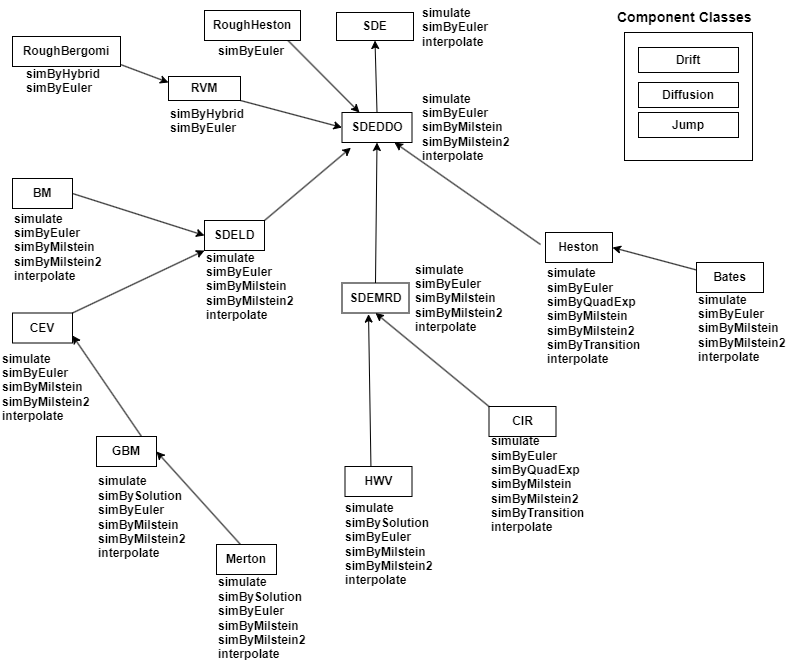drift
漂移率模型分量
说明
drift 对象指定连续时间随机微分方程 (SDE) 的漂移率分量。
漂移率设定支持模拟 NVars 个状态变量(由 NBrowns 个布朗运动风险源驱动)在 NPeriods 个连续观测周期内的样本路径,以便逼近连续时间随机过程。
漂移率设定可以是采用以下一般形式的任何 NVars×1 向量值函数 F:
其中:
A是一个NVars×1向量值函数,可使用 (t, Xt) 接口访问。B是一个NVars×NVars矩阵值函数,可使用 (t, Xt) 接口访问。
并且漂移率设定与采用以下形式的向量值 SDE 相关联:
其中:
Xt 是过程变量的
NVars×1状态向量。dWt 是
NBrowns×1布朗运动向量。A 和 B 是模型参数。
漂移率的设定很灵活,可为静态/线性漂移模型提供直接的参数支持。它还可以扩展,能通过接口为动态/非线性模型提供非直接支持。这使得您可以指定几乎任何漂移率设定。
创建对象
描述
DriftRate = drift(A,B)DriftRate 模型分量。
使用以下类型之一指定所需的输入参数 A 和 B:
MATLAB® 数组。指定数组表示静态(非时变)参数设定。此数组完全捕获与参数形式明显相关的所有实现细节。
MATLAB 函数。指定函数可为几乎任何静态、动态、线性或非线性模型提供间接支持。此参数通过接口支持,因为所有实现细节都隐藏并被函数完全封装。
注意
您可以根据需要指定数组和函数输入参数的组合。
此外,如果函数接受标量时间 t 作为其唯一输入参量,则将参数识别为时间的确定性函数。否则,系统将假定参数为时间 t 和状态 X(t) 的函数,并使用两个输入参量调用。
您创建的 drift 对象封装了复合漂移率设定并返回下面显示的参数:
Rate- 漂移率函数 F。Rate是漂移率计算引擎。它接受当前时间 t 和NVars×1状态向量 Xt 作为输入,并返回一个NVars×1漂移率向量。A-A输入参量的访问函数。B-B输入参量的访问函数。
输入参量
输出参量
属性
示例
详细信息
算法
当您将输入参量 A 和 B 指定为 MATLAB 数组时,它们将与线性漂移参量式相关联。相比之下,当您将 A 或 B 指定为函数时,您可以自定义几乎任何漂移率设定。
在没有输入的情况下访问输出漂移率参数 A 和 B 只会返回原始输入设定。因此,当您不带输入调用漂移率参数时,它们的行为就像简单的属性,您可以测试指定的原始输入的数据类型(是双精度值还是函数,即是静态的还是动态的)。这对于验证和设计方法非常有用。
当您使用输入调用漂移率参数时,它们的行为类似于函数,给人以动态行为的印象。参数 A 和 B 接受观测时间 t 和状态向量 Xt,并返回适当维度的数组。具体来说,参数 A 和 B 会计算相应的漂移率分量。即使您最初将输入指定为数组,drift 也会将其视为时间和状态的静态函数,这样可以确保所有参数都可由同一接口访问。
参考
[1] Aït-Sahalia, Yacine. “Testing Continuous-Time Models of the Spot Interest Rate.” Review of Financial Studies, vol. 9, no. 2, Apr. 1996, pp. 385–426.
[2] Aït-Sahalia, Yacine. “Transition Densities for Interest Rate and Other Nonlinear Diffusions.” The Journal of Finance, vol. 54, no. 4, Aug. 1999, pp. 1361–95.
[3] Glasserman, Paul. Monte Carlo Methods in Financial Engineering. Springer, 2004.
[4] Hull, John. Options, Futures and Other Derivatives. 7th ed, Prentice Hall, 2009.
[5] Johnson, Norman Lloyd, et al. Continuous Univariate Distributions. 2nd ed, Wiley, 1994.
[6] Shreve, Steven E. Stochastic Calculus for Finance. Springer, 2004.
版本历史记录
在 R2008a 中推出
